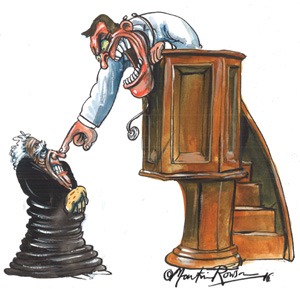
This article is a preview from the Winter 2018 edition of New Humanist
For more than eight hours, a 75-year-old woman lay injured just above a vertical cliff face before her cries for help were noticed. While walking on the High Tor hill in the Peak District at 10am the woman slipped and fell from the path, about 50 feet through trees and rocks, picking up injuries on both legs, before her fall was stopped by a tree. Her cries for help were eventually heard by a dog walker and a gruelling rescue effort began. Police and ambulance responders were unable to reach the woman because of where she had fallen, so mountain rescue were called in.
Volunteers from the Derby and Buxton mountain rescue teams had to abseil down the cliff to reach the woman, whom they found in jovial spirits. A coastguard helicopter was called in but was unable to lift the woman out, so the volunteers used ropes to lift a stretcher which was carried to an ambulance. It was 1am by the time she reached the hospital. Buxton’s mountain rescue team had left their regular meeting that night to help with the rescue. Some of their volunteers didn’t get home till 3am.
Mountain rescue teams embody what the Russian geographer Peter Kropotkin described as “mutual aid” when he wrote about it around the turn of the 19th and 20th centuries, which he defined as “the social instinct – for the preservation of the species”. Kropotkin often cited Britain’s lifeboat associations as an example, once describing them as “one of the noblest achievements of our century”. Had he lived a bit longer he would have talked about mountain rescue teams, which first appeared in the UK in the late 1940s. In Kropotkin’s day, walking in the hills was largely a preserve of the wealthy, but as mountaineering became more popular, people began to flock to the mountains.
The surge of interest in the mountains and hills saw the number of accidents increase, and as accidents happened, they spurred the development of mountain rescue. The first proper voluntary teams in England were established in the Lake District in 1947: Coniston’s was started because a local council couldn’t afford to pay for a team and
Kewick’s because the locals had seen the police give up on a search for a missing climber and thought they could do a better job themselves. Both of these developments would have impressed Kropotkin, who spent his lifetime arguing people were capable of running their lives themselves without the involvement of the state.
Everybody involved in the Buxton Mountain Rescue Team (BMRT) is a volunteer, which is in keeping with how Kropotkin saw mutual aid working – based on voluntary co-operation. There are currently 54 members of the team, with 12 trainees and around 40 people in a variety of support roles. When the team are called out, through the police, all the members are sent a text message asking if they’re available. The team aims to get 15 to 20 members out to most calls, enough to have two teams of eight carrying a stretcher, with extra people to fulfil other roles. Some have been volunteering for 40 years, others have just begun.
I joined BMRT on a training exercise at their Dove Holes base, just north of Buxton, to learn more about the team and find out what motivates the volunteers. “You always want to put something back into where you take something from,” explains former chairman Richard Dooran, who has been involved with BMRT for over 30 years. But altruism is far from the only explanation.
“It’s a social thing for us as well,” says paramedic Dave Goodman, who acts as medical officer for the team. “You become friends with the people you’re with. We do get stuff out of it, we get the excitement, the friends and the giving and helping people.” The sense of community in the team and the excitement which comes from the call outs, or “jobs” as the team call them, are the main reasons the volunteers give for their involvement.
While waiting for the helicopter to arrive for the team to practise rescues, we sit down with Rick Mobbs, the elected chairman of BMRT, who tells us about the team members’ diverse backgrounds. Mobbs explains: “The people that stay the longest are socially committed and are pretty intelligent and are able to cope with the training and things changing.”
Many of the volunteers have backgrounds in the outdoors, although not all, says Mobbs. Some have been outdoors instructors, others have spent their lifetimes hiking or climbing. It was an experience on Snowdon while ice climbing in the winter that motivated Mobbs to seek out the Buxton team when he moved to the Peak District. “A guy had a heart attack on the summit and we helped treat him, on the summit, with mountain rescue people who were there from Llanberis,” he recalls. “He died unfortunately. We carried him down but it stuck in my mind that mountain rescue was cool. These guys came out of nowhere. One of their guys was running up with his dog and a radio and managed to co-ordinate this big rescue with helicopters and loads of people, paramedics turning up with de-fibs and that kind of stuff.”
After the helicopter has arrived and left with a number of volunteers in the back (this is one of the perks which the volunteers enjoy), we’re awaiting its return so more volunteers can practise winching people into the helicopter. Carina Humberstone, the team’s training officer, who has organised the day’s exercise, tells us: “As horrible as it sounds, you want a job that does push you and excite you and get you to use your skills. We go out helping everyone and our usual bread and butter job is normally someone not far from the road with an injured ankle so we go and put a splint on it, put them on a stretcher and carry them to the road. But the ones we talk about for years after are the ones in difficult situations. The ones that last for hours in the snow storms, in the dark.”
The High Tor rescue shows how the mountain rescue teams work closely with the emergency services and other parts of the state. All three emergency services and the coast guard were involved. On other rescues, the team has worked with the air ambulance service. The Home Office carries out regular inspections of the team’s drugs. While mountain rescue is self-organised, it is intertwined with the government and emergency services.
I ask Josh Hall, a young paramedic who joined the team after studying voluntary organisations at college, if the state should be more involved in mountain rescue: “It’s a bit of a fine line, because the more support you get the more involved they get. Mountain rescue is very well organised within itself anyway, it’s got its own regulations.”
Nearly all of the volunteers we speak to echo these sentiments, with one suggesting the further government involvement could amount to “interference”. It also could discourage volunteers from offering up their time. Goodman explains: “I’m not sure I’d like to have money directly from government because with that they perhaps would want to change how we do things. We volunteer our time because we enjoy what we’re doing.”
Money comes from a range of sources: most casualties make donations after being rescued; large sums come from grants, lottery funding and local government. But a significant chunk of the £45,000 a year it takes to run the team comes from the local community. Pubs and cafés in the area have collection boxes on the counters which raise thousands. People donate on the street and charity raffles. Quiz nights and benefit concerts also bring in money.
Mountain rescue teams are a shining example of what Kropotkin meant when he talked about mutual aid. They’re self-organised, run by volunteers and are given material support from the communities they operate in and the people they help. If they’re going to continue providing this help, then they need all of our support
You can donate to BMRT by visiting www.buxtonmountainrescue.org.uk/support_us/donate

